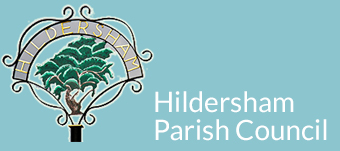(Link to:) Biodiversity Champions across Hildersham (April 2024)
Hildersham Nature Recovery Plan (2022) :
Under the Natural Environment and Rural Communities Act (Sec. 40; see also Sec. 41), Hildersham Parish Council, in common with every other public authority, must always show regard for conserving biodiversity. (See also Sec. 102 of the Environment Act 2021; the Biodiversity Strategy for England: Biodiversity 2020; the expected announcement of a legally-binding target for 2030 to drive action to halt the decline of nature and wildlife).
UN Biodiversity Conference (COP 15), Montreal 2022
Biodiversity Emergency (South Cambs.)
Cambridgeshire Nature Network (Cambridge Past, Present and Future)
Climate Emergency and nature (South Cambs.)
– Doubling Nature Strategy (2021)
– Local Nature Recovery Toolkit (Sep 2020)
HNRP – Gardens Questionnaire (Sep 2022)
HNRP – Gardens Questionnaire Report (Nov/Dec 2022)
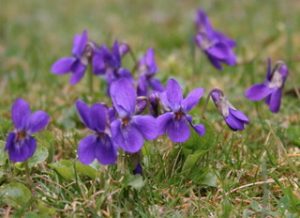
Dog violets (Photo credit: Carol Sinclair)
Environment Act 2021: 2.2.7. The Act introduces a statutory requirement for Local Nature Recovery Strategies to be produced by a responsible authority appointed by the Government. The responsible authority is likely to be either the Local Nature Partnership or Cambridgeshire County Council. These strategies will map important habitat areas where there is an opportunity to improve the local environment to guide biodiversity net gain and other policies.
In the spring of 2020, Hildersham Parish Council demonstrated their concern for biodiversity by giving formal support to the Pollinator Action Plan (for more information on PAPs, see the Horseheath PC website).
One of the principal concerns of the PAP is to encourage bees, which play a very important role in the pollination of plants that provide food for us.
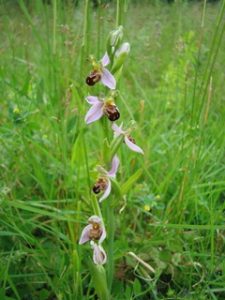
Bee orchid – Ophrys apifera – formerly growing on Hildersham allotments (North Holding) (Photo credit: Carol Sinclair)
(More on local pollinators).
Bees
In recent years, bees have been finding it ever more difficult to survive, especially as the countryside is suffering contamination by chemicals from pesticides and weedkillers. In time to come, more than 30 species of bees could become extinct.
Gardens free of weed-killers and pesticides can also grow flowers that encourage bees: buttercups, red clover, nepita (cat mint), annual dahlias, cornflowers, hellebores, lavender, alliums, caryopteris, verbena bonariensis, and muscari.
Pesticides
There is growing evidence of the harmful effects that pesticide use can have on pollinators and other wildlife. Local Authorities should aim to use pesticides only if absolutely necessary … and avoid using pesticides on flowering plants or where pollinators are active or nesting.
Of particular concern is the use of neonicotinoid pesticides. (“Helping pollinators locally,” #5, p. 14, PDF 16).
Bee-harming pesticides found in majority of English waterways (Dec 2024)
Bees and farm pesticides (BBC)

Lesser celandine (Photo credit: Carol Sinclair)
Butterflies
The butterflies we may never see again in Britain (BBC)
Hedgehogs
Important conservation tips for hedgehogs can be found in Linton News, Oct 2021: 2; “1000 mile slog for our beautiful hogs:”
• Leave water out in shallow bowls during drier periods (Leaving water for hedgehogs ‘may save life’ in hot spell)
• Leave an untidy patch in your garden where they can hide
• Make a small hole in your fence for free access
• Check before strimming, as hedgehogs could be resting.
if a hedgehog is found out in daylight, this could indicate that it might need care. The website Hedgehog Street includes a link to carers and rescue centres.
Verges
Part of the thinking behind the Pollinator Action Plan incorporates a strategy designed to encourage councils to reconsider a desire for neatness and tidiness, and to let “neatly-mown grass verges become mini meadows where wildflowers and wildlife can flourish”. Bees love displays of wild flowers such as cow-parsley, which attract insects known as diptera, on which local bird-life (spotted flycatchers [Muscicapa striata], on the Red (Endangered) list): PDF 2) feed during the breeding season.
“Changing mowing regimes on road verges etc. [would] allow more wildflowers to bloom naturally. Roadside verges and roundabouts are often maintained as short grassland. This may be required for road safety purposes but often it is just carried out as it has always been done this way. Reducing cutting frequencies, or creating wildflower lawns or meadows can be an effective way to provide attractive areas beneficial to pollinators and potentially reduce management costs. Likewise hedge cutting regimes can be changed to allow better structure to develop in hedgerows and flowering shrubs to bloom for longer.
“The precise timing of mowing regimes depends on the vegetation being managed. As a general rule nectar-rich plants should be allowed to finish their flowering period. Early flowering species such as Dandelion and Primrose are of particular value for pollinators as they emerge in the spring.” (“Helping pollinators locally:”#4, p. 14, PDF 16).
In cases where there is concern for appearance and/or road safety, it’s advised that no more than a narrow fringe be cut at the front of the verge – as shown in this photograph taken by councilmember Rob Clay, in charge of grass-cutting (2021).
Centre of Hildersham, May 2021: Flowers blooming; grass border trimmed.
Hildersham Churchyard writes (May 2021):
“As we journey through the seasons, we are hoping to allow areas of the churchyard to become a haven for all manner of wildlife while retaining a respectful and caring attitude towards the gravestones and memorials.
“So, if you are passing in midsummer and the grass looks long and overgrown, it is actually the beginnings of our summer meadow that will hopefully bring birds, flowers, butterflies and bees to glorify what is already a beautiful space.”
2021 Hildersham Churchyard award
Endangered/declining species in Hildersham
– Spotted flycatcher ( Muscicapa striata)
The South Cambs region records only 10-15 pairs each year. This is now a “red-listed” species of high conservation concern – ( Red (Endangered) list): PDF 2)
– Meadow saxifrage (Saxifraga granulata)
– Pasqueflower (Pulsatilla vulgaris Miller [Anemone pulsatilla L.])
– Bee orchid (Ophrys apifera [see above])
Amongst other species far less common than in former years are hedgehogs (family Erinaceidae, and see above); and toads (family Bufonidae).
Other Wildlife and Ecology Initiatives in Cambridge:
King’s College meadow harvested with horses (BBC)
Pyramids at risk in Hildersham? Greater Cambridge Partnership to the rescue!
Recently (July 2021), residents noted the presence of a species of orchid (pyramidal orchids, or anacamptis pyramidalis) growing at a precarious location within the parish. Cambridgeshire Wildlife Trust explained that the orchids could not be moved, as they needed to grow surrounded by a specific mycorrhizal fungus. Because of concerns for the plant’s safety, a protective barrier has now been placed around it (thanks to Cllr. Henry Batchelor and Greater Cambridge Partnership).
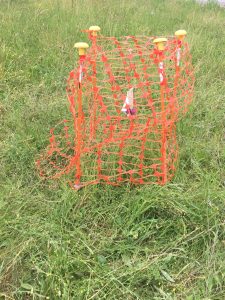
(Photo credit: Greater Cambridge Partnership)
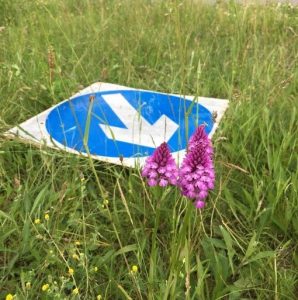
(Photo credit: J. Sinclair)
Should wild flowers be planted on verges?
A tempting idea – but opinions vary! There is a danger in bringing in inappropriate species, such as the commonly sold “pastoral mix'” that includes non-native species like Californian poppies. Great for pollinators, but not necessrily good for country villages that may still have their native wild flowers.
A helpful article on the Plantlife website explains the controversy very well.
Additional Links:
King’s College meadow harvested with horses (BBC)
Cambridgeshire Beekeepers’ Association
Cambridge Past, Present and Future
Friends of the Roman Road and Fleam Dyke
Hildersham Verges Report – August 2015
Prize-winning Weed Garden (BBC video, 01:14)
Wildlife Trust for Cambridgeshire, Bedfordshire and Northamptonshire (promoting 30 Days Wild 2021)
National sites:
Plantlife (promoting #NoMowMay)
Wildlife and Countryside Act 1981 – Wiki
Habitat Maps (2015):
(These maps are due to be updated at some point by CPERC)
Hildersham Broad Habitat Map Centre
Hildersham Broad Habitat Map North
Hildersham Broad Habitat Map South
Hildersham Phase 1 Parish map 1 North
Hildersham Phase 1 Parish map 2 Centre
Hildersham Phase 1 Parish map 3 South
Added:Hildersham species list CPERC records 09-2015 v1
Photographs request
Do any Hildersham residents or visitors have any photographs of verges or gardens with the sort of flowers that attact bees and insects that could be included on this page? If so, please contact the Parish Council.
Nature Recovery Plan Survey and Report: 2023
Spreadsheets: 1-6a:
HNRPVS 2 – LH, EC, JH – 22 4 23
Doc. 2 – Verges Survey Data Report – April-May 2023
Doc. 3 – Discussion (Verges Survey April 2023)
Doc. 4 – (Proposed verges management) – (Verges Survey April 2023)
